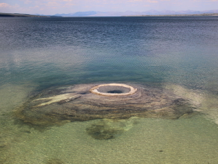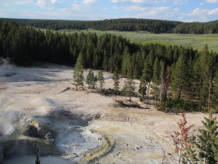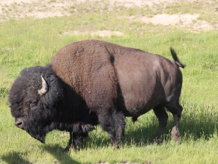Nauru Travel Diary

From Houston to Sydney 2013
From Houston
to Sydney
2013
How can I do justice to today’s travels? We spent almost 12 hours doing non-stop visits in the south-western quarter of Yellowstone National Park – surely one of the true geographical gems of the world – and I feel I could only do justice to describing what we saw by writing a medium sized geography textbook. As I am finally starting to write this blog at 10 pm at night, you will be spared the textbook analysis.
In order to make the most of our travelling time today, we decided to miss breakfast and take our packed lunches with us to eat when we got hungry; our hotel helpfully prepares packed lunches for its guests as part of the room rate. Even so, it was 9 am before we left the hotel, and because we are staying just outside the western gate of Yellowstone National Park, it was half an hour later before we arrived at our first stopping point.
With an area of almost 9000 square kilometres, Yellowstone was the world’s first national park – it is the place where the concept of the national park was invented. Located on the continental divide of North America, its distinctive character is based on volcanic and thermal activity. It is a high altitude thermal wonderland as a consequence of a massive volcanic explosion 640,000 years ago during which most of the central area of what is now the park exploded, leaving behind a smoldering caldera that measures about 75 by 50 kilometres. The area is still regarded as a super-volcano which could explode once again in the not-too-distant future (as several Hollywood movie producers can attest), potentially resulting in a global climatic disaster.
Such thoughts seemed far from the minds of our fellow travellers today, a diverse and very large gathering of tourists from every state of the US judging by the license plates we saw on the cars in the overflowing car parks – and yes, even Alaska and Hawaii were represented.
Our first stop was a brief one, and unrelated to the thermal sights that attract most of Yellowstone’s visitors. Turning southwards at Madison, we stopped at Firehole Falls, a series of waterfalls surging downwards in a narrow canyon that seemed to be guarded by a perky little chipmunk, at least when we were there this morning.
Continuing south from Madison, we then arrived at the first of several spectacular thermal zones. Our first area was known as Fountain Paint Pot, and it was located right beside the road. This was a wonderfully diverse set of thermal features, focused around a large cauldron of pinkish boiling mud, popping, blopping and plopping at a rapid rate while clouds of steam rose overhead. Other features in the area included geysers, fumaroles, hot springs and hot streams, often coloured a bright orange due to the bacterial growth in the water.
We have come to expect that US National Parks are superbly set up for visitors, and Yellowstone is no exception; at Fountain Paint Pot and many of the other sites we visited today, wide boardwalks guided visitors safely through the thermal areas, providing safe access for everyone, including young children and the disabled.
Our second area was a little less accessible, however, being closed to buses and RVs, although boardwalks still featured prominently. This was the Firehole Lake Drive, a circuit that included clear blue hot springs surrounded by orange rims (once again as a result of bacterial activity), a cone geyser, several ‘flat’ geysers, and a series of waterfalls comprising boiling water.
Our third stop was perhaps the most beautifully spectacular of the day. Known as the Midway Geyser Basin, it comprised the large crater of Excelsior Geyser (which produces about 18,000 litres of boiling water per minute) and the wonderfully colourful Grand Prismatic Spring, a kaleidoscope of bright colours arising from the various types of algae, bacteria and archaea that thrive at different temperatures.
By 1 pm, we were becoming a bit hungry despite the fascination of the sightseeing, so we headed a little further south to Old Faithful. Named after the world famous Old Faithful Geyser, Old Faithful is the focus of activity in the Park, housing the largest visitors’ centre in the park, some huge hotels, and many of the services. As we already had our lunches with us, the big challenge was finding a parking spot, and then finding somewhere to sit. Neither challenge was simple to address, but eventually we finished our lunches and attended to the next priority – watching the eruption of Old Faithful Geyser.
Old Faithful is supposed to erupt every 90 minutes or so, and the sign in the Visitors’ Centre confidently proclaimed “Next Eruption: 2:11 pm, plus or minus 10 minutes”. With a thousand or so others, I stood and waited for the eruption from about 1:45 pm, just in case the eruption came a little early. I need not have been so punctual; after several false starts, the eruption finally came at 2:25 pm to the cheers of the onlookers. It was worth the wait; the water spurted over 20 minutes into the air and the eruption lasted for several minutes.
The thermal features at Old Faithful are not confined to one famous geyser, of course, so after the big eruption, Di and I completed a circuit of the boardwalk through a galaxy of thermal features – boiling springs, fumaroles, several smaller erupting geysers, small flowing streams of boiling water, and so on.
Eventually it was time to tear ourselves away as we were planning on completing the circular road from Old Faithful through West Thumb, Canyon Village, Norris and Madison back to West Yellowstone before the end of the day. We proceeded east from Old Faithful and crossed the Continental Divide twice – first at Craig Pass (8262 feet / 2518 metres) and then at a higher unnamed pass (8391 feet / 2558 metres), before descending to West Thumb.
Located at the south-west corner of Yellowstone Lake, the vast water body that fills much of the Yellowstone caldera, West Thumb has a small thermal area that we stopped to visit. In many ways, the springs and geysers in this thermal area were less spectacular than the ones we had seen earlier in the day, but the stop was worthwhile for three reasons. First, the springs and geysers were beautifully situated overlooking the blue waters of Yellowstone Lake. Second, there were some significantly different features, such as the two cones of boiling water in the offshore waters of the lake. And third, we had the rare opportunity to see a female elk in the wild walk right past us to graze on some grass in the middle of the thermal area (well insulated hoofs?).
This was the beginning of a fascinating afternoon of spotting wildlife as we proceeded further north along the western side of Yellowstone Lake. North of West Thumb we noticed several cars stopped beside the road, and then Di spotted the reasons – a magnificent male elk resting in the shade among the trees of the forest. Then a few more miles northward, some more cars beside the road signified more wildlife, in this case, a bison resting on the banks of the stream that was running beside the road.
Our next ‘thermal’ stop brought even more wildlife surprises. We stopped at a feature known as the “Mud Volcano”, but which actually comprised an array of geysers, hot lakes, a few boiling cauldrons and a hot string gushing from a cave in a cliff in addition to the boiling mud pool.
The real surprise, however, was finding two bison resting beside the steaming sulphurous pools of boiling water, apparently warming themselves in the steam that was being blown from the waters by the wind. While we were there, they were joined by two more bison, one of which proceeded to roll around in the hot dust near one of the boiling cauldrons before walking on to the boardwalk where I was busy taking photos. Bison can be aggressive, but fortunately these bison seemed very placid – maybe they had been inhaling sulphur fumes for too long.
Our final planned stop was a large sulphur cauldron located right beside the road – the strong sulphurous aromas here precluded any serious possibility of wildlife spotting there! However, the stops for wildlife were not yet over. As we drove west from the sulphur cauldron, we encountered a large herd of bison, including several young calves, grazing on the river flats right beside the road – a magic sight in the golden sunlight of the late afternoon. And finally, as we approached Norris, a family of elk could be seen on the river flats very close to the road; a male, a female and two young elks.
Thus, what began as a day to see thermal landforms morphed happily into a day of extraordinary wildlife spotting as well as achieving the primary aim of seeing and experiencing the world’s largest, most diverse and most impressive array of volcanic features anywhere in the world.
What a great day!

Day 5 - Yellowstone National Park
Wednesday
10 July 2013









































